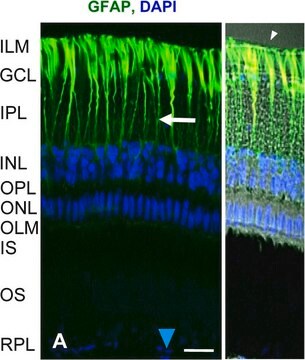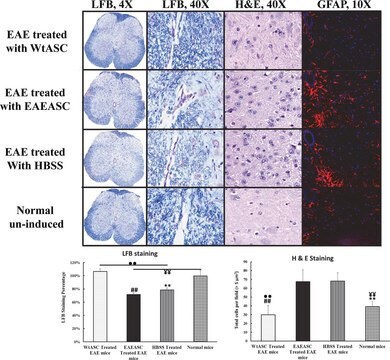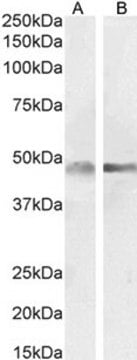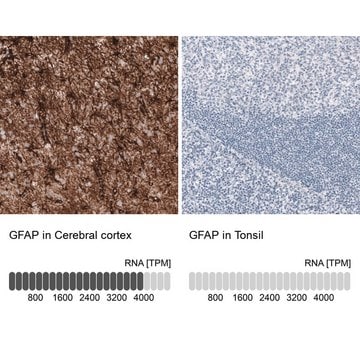G9269
Anti-Glial Fibrillary Acidic Protein antibody produced in rabbit
IgG fraction of antiserum, buffered aqueous solution
Sinónimos:
GFAP Antibody Sigma - Anti-Glial Fibrillary Acidic Protein antibody produced in rabbit, Gfap Antibody Sigma, Anti-GFAP
About This Item
Productos recomendados
origen biológico
rabbit
Nivel de calidad
conjugado
unconjugated
forma del anticuerpo
IgG fraction of antiserum
tipo de anticuerpo
primary antibodies
clon
polyclonal
formulario
buffered aqueous solution
reactividad de especies
rat, human
envase
antibody small pack of 25 μL
técnicas
immunohistochemistry (formalin-fixed, paraffin-embedded sections): 1:80 using brain sections
microarray: suitable
western blot: 1:500 using brain extract
Nº de acceso UniProt
Condiciones de envío
dry ice
temp. de almacenamiento
−20°C
modificación del objetivo postraduccional
unmodified
Información sobre el gen
human ... GFAP(2670)
rat ... Gfap(24387)
Descripción general
Especificidad
Inmunógeno
Aplicación
- immunohistochemical staining at a working dilution of 1:400 using rat brain sections
- immunohistochemical staining of human brain tumor tissue specimens to identify the cells expressing AQP4 (Aquaporin-4)
- immunofluorescence using brain section from mice
Acciones bioquímicas o fisiológicas
Forma física
Almacenamiento y estabilidad
Cláusula de descargo de responsabilidad
¿No encuentra el producto adecuado?
Pruebe nuestro Herramienta de selección de productos.
Producto relacionado
anticuerpo
Código de clase de almacenamiento
12 - Non Combustible Liquids
Clase de riesgo para el agua (WGK)
WGK 2
Punto de inflamabilidad (°F)
Not applicable
Punto de inflamabilidad (°C)
Not applicable
Certificados de análisis (COA)
Busque Certificados de análisis (COA) introduciendo el número de lote del producto. Los números de lote se encuentran en la etiqueta del producto después de las palabras «Lot» o «Batch»
¿Ya tiene este producto?
Encuentre la documentación para los productos que ha comprado recientemente en la Biblioteca de documentos.
Los clientes también vieron
Nuestro equipo de científicos tiene experiencia en todas las áreas de investigación: Ciencias de la vida, Ciencia de los materiales, Síntesis química, Cromatografía, Analítica y muchas otras.
Póngase en contacto con el Servicio técnico













